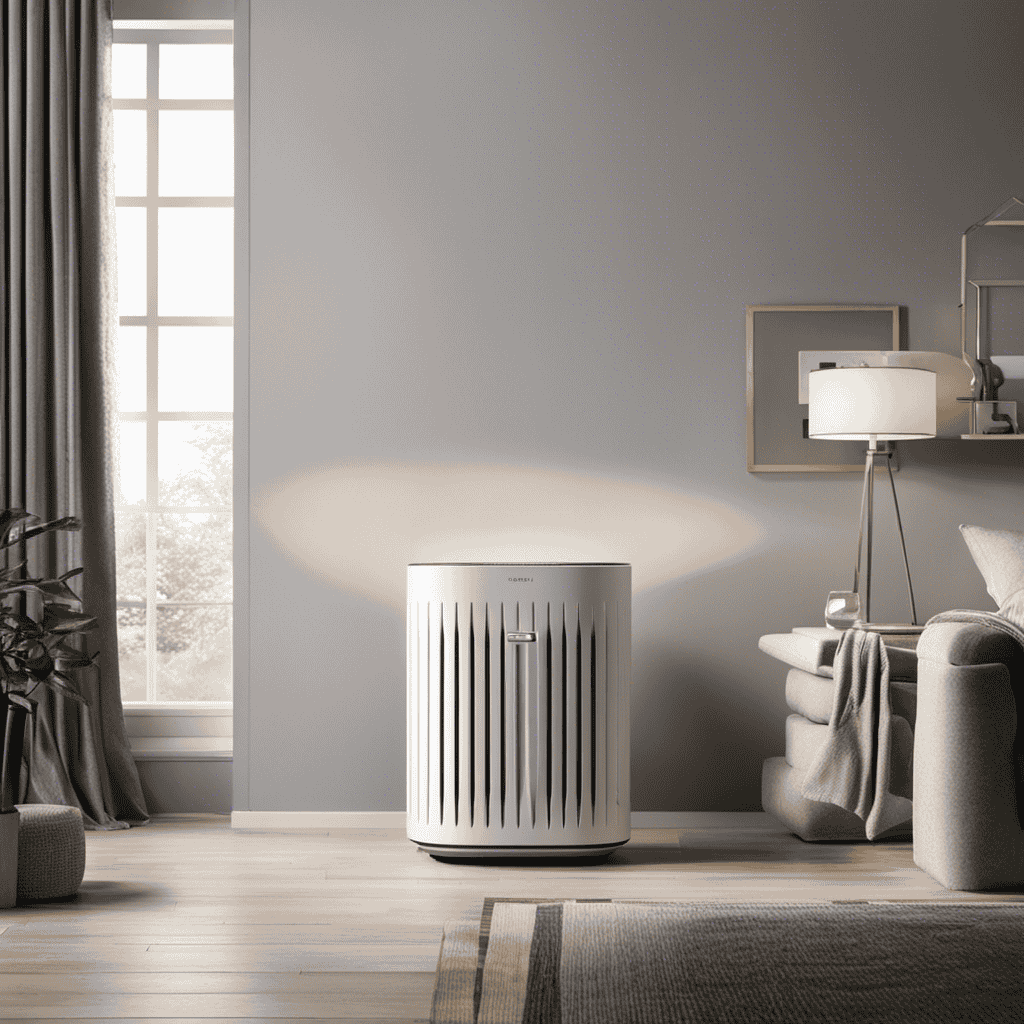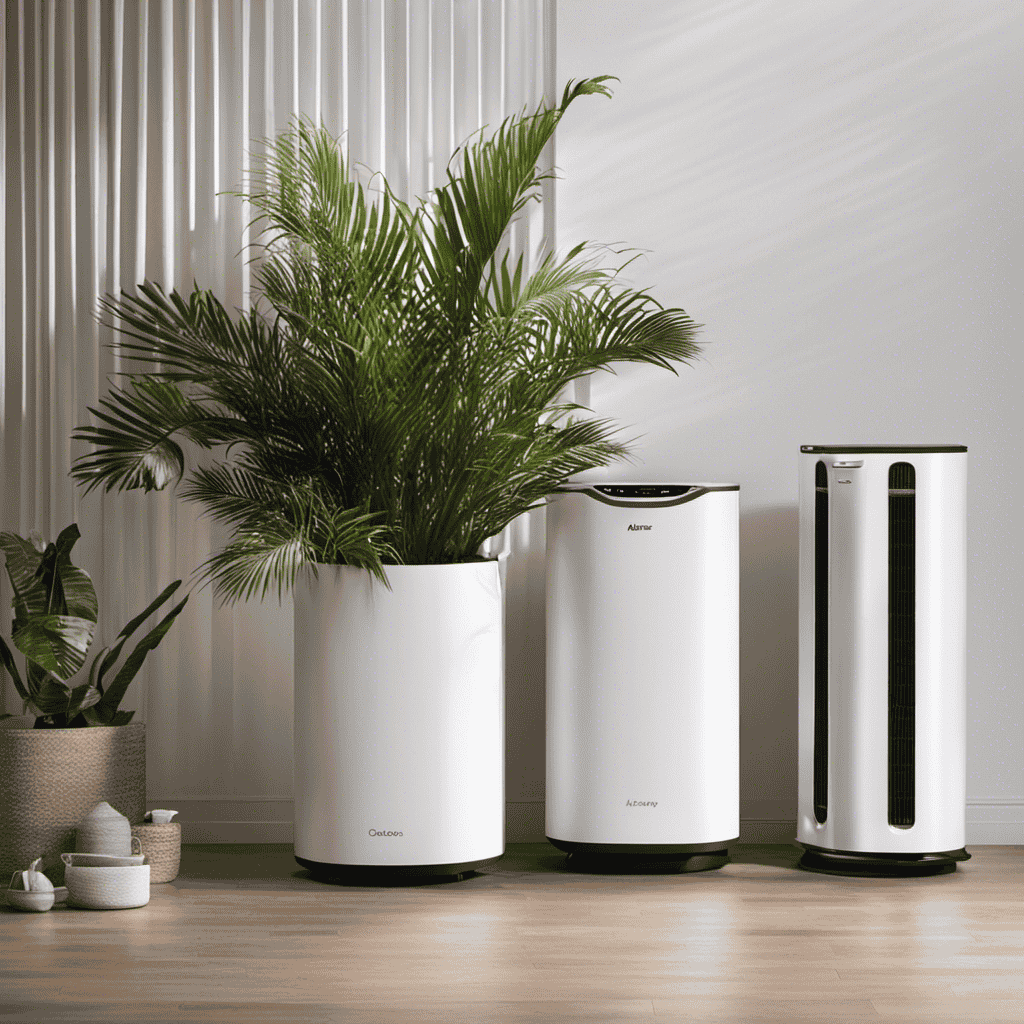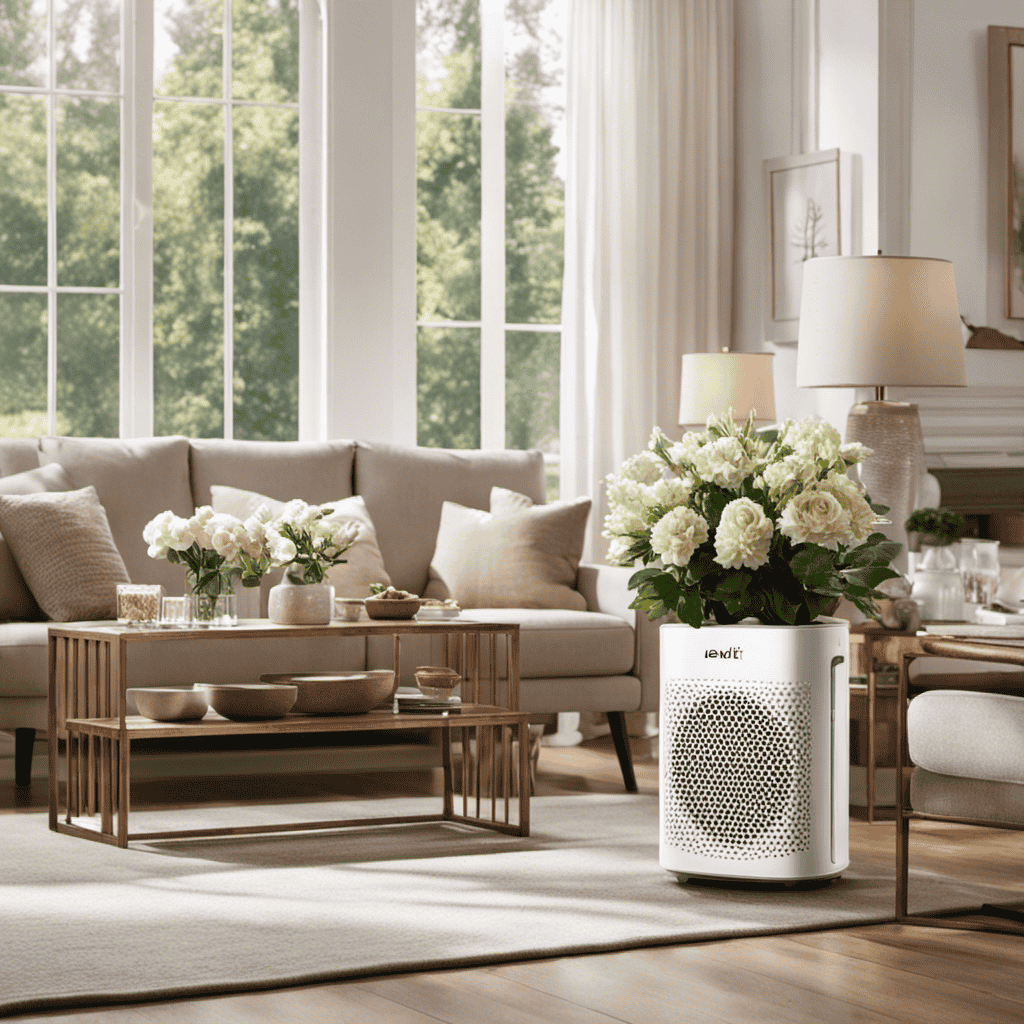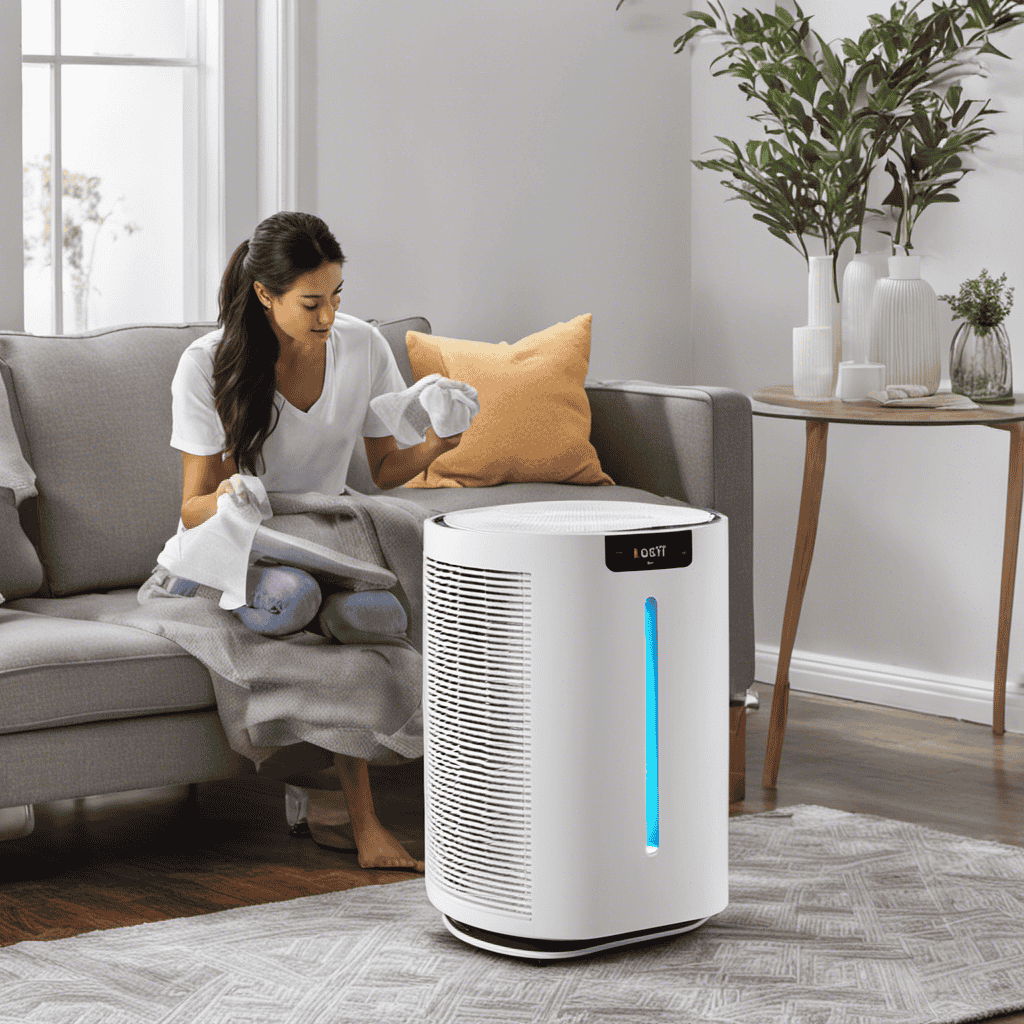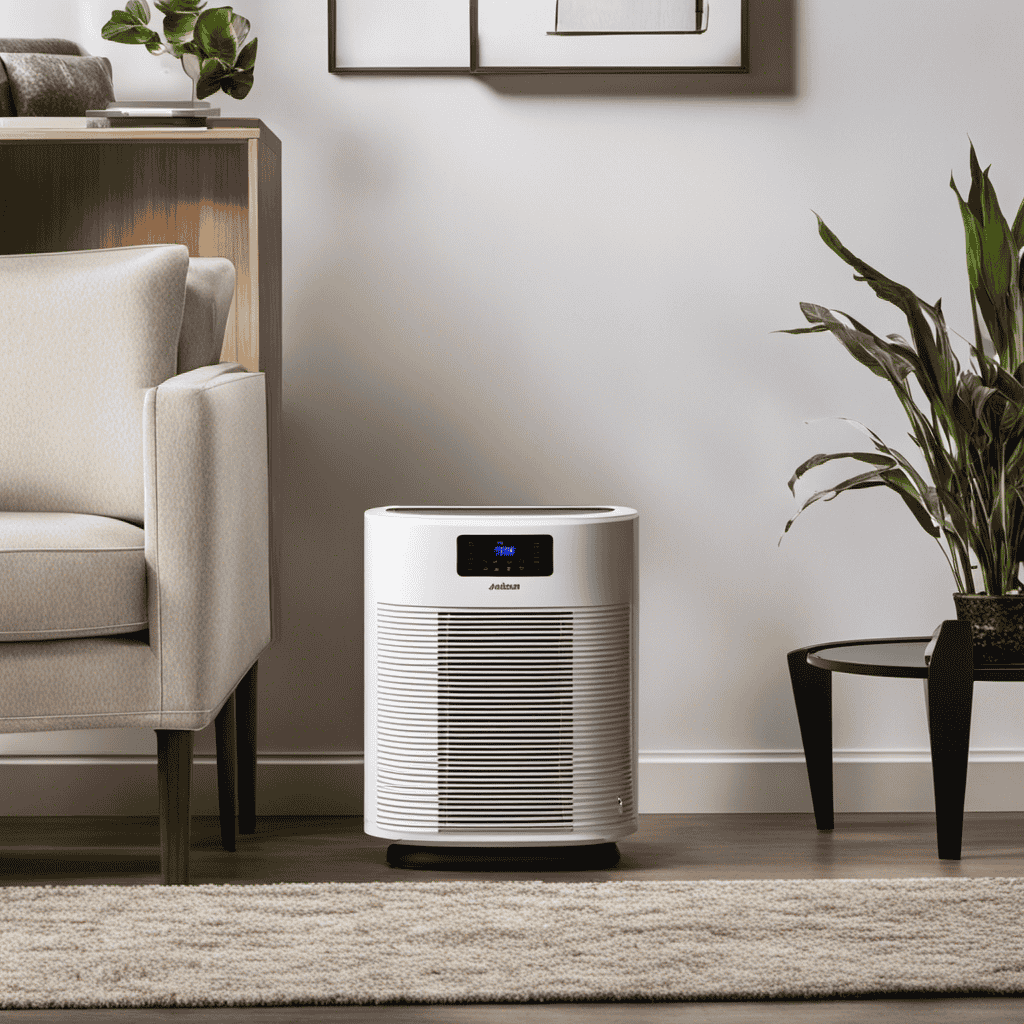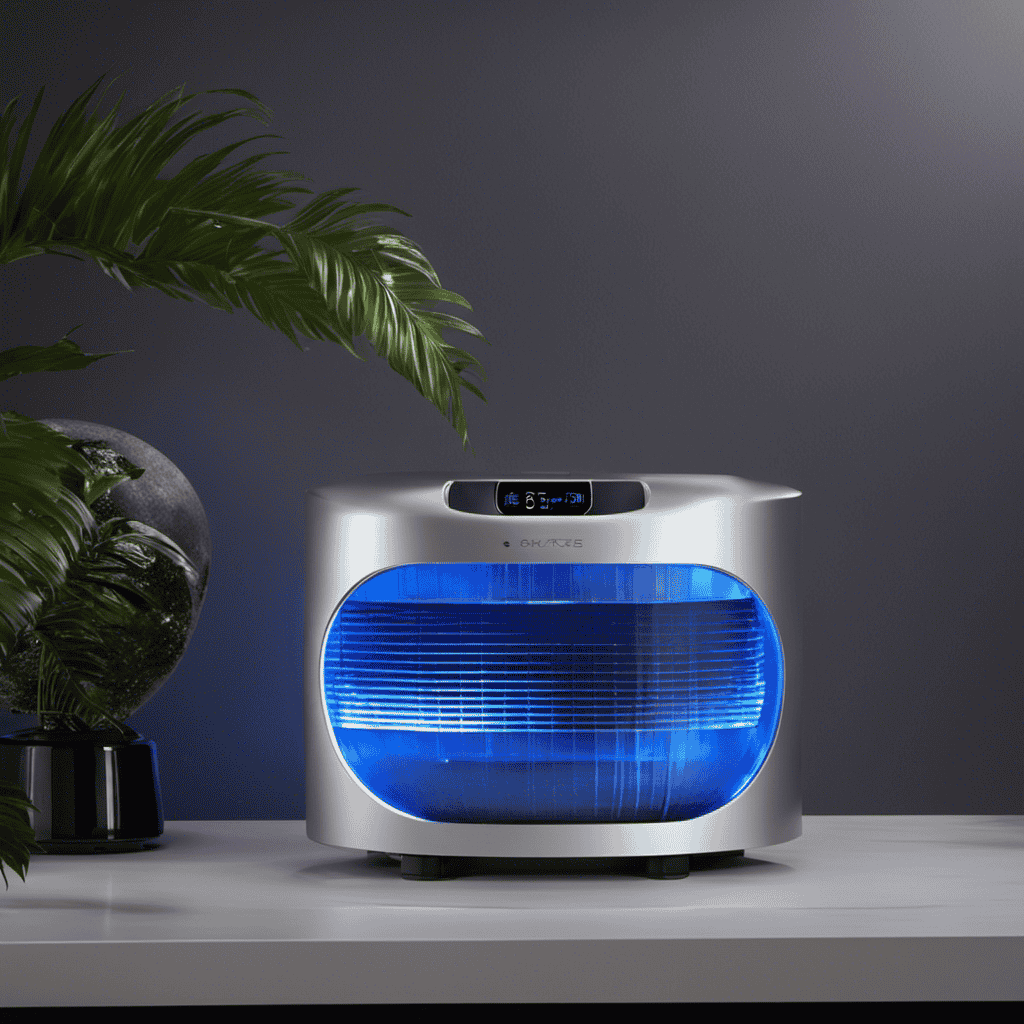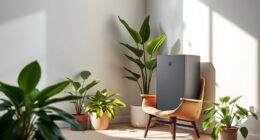As a owner of an air purifier, I frequently question how frequently I should replace the filter. This is an essential maintenance duty that directly influences the purifier’s efficiency and effectiveness.
In this article, I will provide you with all the information you need to know about the recommended frequency for filter changes. By understanding the factors affecting filter lifespan and the signs that indicate replacement, you’ll be able to optimize your air purifier’s performance and ensure clean and healthy air in your space.
Key Takeaways
- Air quality and pollution levels impact the lifespan of air purifier filters.
- Different types of filters have varying lifespans, with HEPA filters lasting longer than carbon filters.
- Regular filter changes, typically every 3 to 6 months, help maintain clean and healthy indoor air quality.
- Signs of a clogged filter include reduced airflow, decreased efficiency, and increased dust and particles in the air.
Factors Affecting Filter Lifespan
There are several factors that can affect how long the filter on your air purifier lasts. The effectiveness of the filter can be influenced by a variety of factors, including the quality of the air in your environment and the specific type of filter you are using.
One of the main factors that affects filter effectiveness is the air quality in your surroundings. If you live in an area with high levels of pollution or allergens, your filter will have to work harder to clean the air. This can lead to a shorter lifespan for the filter, as it becomes clogged and less efficient over time.
Another factor to consider is the type of filter you are using. Different filters have varying lifespans, depending on their design and materials. For example, a HEPA filter typically lasts longer than a carbon filter, as it is designed to capture smaller particles and can be cleaned more easily.
In conclusion, the effectiveness of your air purifier filter can be impacted by various factors, including the air quality in your environment and the type of filter you are using. Understanding these factors can help you determine how often you need to change your filter to maintain optimal performance.
Now, let’s explore the different types of air purifier filters in more detail.
Types of Air Purifier Filters
You should consider the different types of filters available for your air purifier.
There are several options to choose from, each with its own pros and cons.
The most common type of filter is a HEPA filter, which stands for High Efficiency Particulate Air. These filters are designed to capture particles as small as 0.3 microns, including dust, pollen, pet dander, and smoke. HEPA filters are highly effective at removing airborne pollutants, but they do require regular replacement to maintain their efficiency.
Another type of filter is the activated carbon filter. These filters are excellent at removing odors, chemicals, and volatile organic compounds (VOCs) from the air. However, they are not as effective at capturing larger particles.
Electrostatic filters use an electric charge to attract and trap particles, making them highly efficient at removing pollutants from the air. However, they can be more expensive and may produce ozone as a byproduct.
Finally, there are UV filters, which use ultraviolet light to kill bacteria and viruses. While these filters are effective at sterilizing the air, they are not as effective at removing larger particles.
Ultimately, the type of filter you choose will depend on your specific needs and preferences.
Recommended Filter Change Frequency
When it comes to optimal filter replacement for air purifiers, there are several factors that can affect the frequency at which filters should be changed. These factors include the type of filter being used, the air quality in the environment, and the level of usage the air purifier is subjected to.
It is important to be aware of the signs of a clogged filter, such as reduced airflow and a decrease in air purifying efficiency, in order to ensure that filters are replaced in a timely manner.
Optimal Filter Replacement
The optimal time to change the filter on my air purifier is every 3 to 6 months. This is crucial in maintaining clean and healthy indoor air quality.
Several factors can affect air quality, such as outdoor pollution, dust, pet dander, and allergens. These particles can accumulate in the air and cause respiratory issues, allergies, and other health problems.
Regularly changing the air purifier filter helps to remove these contaminants, ensuring the air we breathe is clean and safe. Clean air has numerous benefits, including improved respiratory health, reduced allergies, and a cleaner living environment.
It is important to prioritize air quality by following the recommended filter change frequency to enjoy these benefits and maintain a healthy indoor environment.
Factors Affecting Frequency
Factors such as outdoor pollution, dust, pet dander, and allergens can impact how often I need to replace the filter on my air purifier. Proper filter maintenance is crucial for ensuring the effectiveness and longevity of the device.
Regularly cleaning and replacing the filters can help maintain optimal air quality and prevent the accumulation of harmful particles. To keep my air purifier running efficiently, I follow a few filter maintenance tips.
Firstly, I check the manufacturer’s recommendations for filter replacement frequency.
Secondly, I inspect the filter regularly for visible dirt and debris.
Thirdly, I clean or replace the filter whenever it appears dirty or clogged.
Signs of Clogged Filter?
To determine if your filter is clogged, simply remove it from the device and check for visible dirt or debris. A clogged filter can greatly reduce the effectiveness of your air purifier, so it’s important to stay on top of filter maintenance.
One of the signs of a clogged filter is reduced airflow. If you notice that your air purifier is not producing as much clean air as it used to, it may be time to replace the filter.
Another sign is a noticeable increase in dust and particles in the air. If you find yourself dusting more frequently or experiencing increased allergy symptoms, it’s a good idea to check the filter and consider replacing it.
Regularly cleaning or replacing your filter is essential for optimal performance and air quality.
Signs That Indicate Filter Replacement
As an air purifier user, it’s important to understand the indicators that suggest a filter is reaching the end of its lifespan and needs to be replaced.
These indicators can include a decrease in airflow, reduced purification performance, and a noticeable decline in air quality.
Filter Lifespan Indicators
The filter lifespan indicators on most air purifiers will let you know when it’s time to change the filter. These indicators are designed to monitor the condition of the filter and take into account various factors that influence its replacement.
Here are three important factors that can influence when you should replace your air purifier filter:
- Air quality: If you live in an area with high levels of pollution or allergens, your filter may need to be replaced more frequently.
- Usage: The more you use your air purifier, the more frequently the filter will need to be replaced.
- Filter type: Different filter types have different lifespans, so it’s important to follow the manufacturer’s recommendations for replacement.
Timely filter replacement offers several benefits, including:
- Improved air quality: A fresh filter ensures that your air purifier can effectively remove pollutants from the air.
- Enhanced performance: A clean filter allows your air purifier to work efficiently, providing you with cleaner and fresher air.
- Longer lifespan: Regularly replacing the filter can extend the lifespan of your air purifier, saving you money in the long run.
Performance Decline Signs
As I mentioned before, there are several factors that can affect the performance of an air purifier filter. Over time, these factors can cause the filter to become worn out and less effective at removing pollutants from the air. It is important to be aware of the signs that indicate a filter is no longer functioning optimally.
One of the most obvious signs of a worn out filter is a decline in air quality. If you start to notice an increase in dust, allergens, or odors in your home, it may be a sign that your filter needs to be replaced. Another sign is reduced airflow. If you feel that the air coming out of your purifier is weaker than usual, it could be due to a clogged or worn out filter.
How to Extend Filter Lifespan
To extend the lifespan of your air purifier’s filter, you should regularly clean or vacuum it. Proper maintenance is crucial for optimal performance and longevity of your air purifier. Here are some filter maintenance tips to help you get the most out of your filter:
-
Clean or vacuum the filter at least once a month: By removing dust, pet dander, and other particles from the filter, you can prevent clogging and ensure efficient air purification.
-
Follow the manufacturer’s instructions: Each air purifier may have specific guidelines for filter maintenance. It’s important to read and follow these instructions to ensure proper care of your filter.
-
Consider using a pre-filter: A pre-filter can capture larger particles, such as hair and lint, before they reach the main filter. This helps to prolong the life of the main filter and reduce the frequency of filter replacements.
By implementing these filter maintenance tips, you can extend the life of your air purifier’s filter and maintain its effectiveness in purifying the air in your home.
However, there are common mistakes that people often make when it comes to filter maintenance, which can negatively impact the lifespan of the filter. Let’s explore these mistakes in the next section.
Common Mistakes in Filter Maintenance
When it comes to filter maintenance, there are common mistakes that many people tend to make.
One of these mistakes is neglecting filter replacement, which can greatly reduce the effectiveness of the air purifier.
Another mistake is incorrect filter installation, which can lead to air leakage and compromised air quality.
Lastly, many people overlook the importance of filter cleaning, which can result in clogged filters and reduced airflow.
Avoiding these mistakes is crucial for ensuring optimal performance and longevity of your air purifier.
Neglecting Filter Replacement
Neglecting to replace the filter regularly can significantly reduce the air purifier’s effectiveness. It is important to understand the consequences of neglecting filter replacement in order to appreciate the benefits of regular maintenance. Here are three key points to consider:
-
Filter Replacement Cost: While it may seem like an added expense, the cost of replacing the filter is minimal compared to the potential health risks and decreased performance of your air purifier. Investing in a new filter ensures that your unit operates efficiently and effectively.
-
Improved Air Quality: Regular filter replacement helps to remove allergens, dust, and other pollutants from the air. By maintaining clean filters, you can breathe easier and reduce the risk of respiratory issues and allergies.
-
Prolonged Lifespan: Neglecting filter replacement can lead to a buildup of debris, which puts strain on the air purifier’s motor. By regularly changing the filter, you can extend the lifespan of your unit and avoid costly repairs or replacements.
Incorrect Filter Installation
In my experience with air purifiers, I’ve come across a common issue that many users face – incorrect filter installation. This can lead to ineffective air purification and even damage to the device itself. To help you troubleshoot and avoid filter installation problems, I’ve created a table outlining some of the most common issues and their solutions:
| Issue | Solution |
|---|---|
| Filter not fitting properly | Double-check the filter size and ensure it matches the device. |
| Filter installed upside down | Refer to the user manual for proper filter orientation. |
| Filter not securely fastened | Make sure the filter is properly locked in place. |
| Filter clogged with debris or dust | Remove the filter and clean it according to the instructions. |
Overlooking Filter Cleaning
To make sure your device is working efficiently, don’t forget to regularly clean the filters. Proper filter maintenance is crucial for the optimal performance of your air purifier. Neglecting to clean the filters can result in reduced air quality and decreased efficiency.
Here are some important filter maintenance tips and best practices for filter cleaning:
-
Regular Cleaning Schedule: Set a regular schedule for filter cleaning based on the manufacturer’s recommendations. This ensures that the filters are cleaned at the appropriate intervals and prevents buildup of dust and pollutants.
-
Proper Cleaning Technique: When cleaning the filters, follow the manufacturer’s instructions carefully. Use a soft brush or vacuum cleaner to remove the accumulated dirt, dust, and debris. Avoid using water on filters unless specifically instructed by the manufacturer.
-
Replacement Filters: In addition to regular cleaning, it is important to replace the filters as recommended by the manufacturer. Over time, filters can become clogged and lose their effectiveness, so it’s crucial to stay on top of filter replacement to maintain the air purifier’s efficiency.
Importance of Regular Filter Changes
Regular filter changes are essential for maintaining the effectiveness of an air purifier. Neglecting to regularly clean or replace the filters can have a significant impact on the performance of the device. Dirty filters can impede the airflow, reducing the purifier’s ability to remove airborne particles effectively. This not only compromises the air quality but also puts the health of the occupants at risk.
To emphasize the importance of regular maintenance, let’s take a look at the impact of dirty filters through the following table:
| Impact of Dirty Filters |
|---|
| Decreased air quality |
| Increased allergens |
| Reduced purifier lifespan |
| Higher energy consumption |
Dirty filters contribute to decreased air quality by allowing pollutants, dust, and allergens to circulate freely. This can lead to respiratory issues, allergies, and other health problems. Additionally, the accumulation of debris on the filters can strain the purifier’s motor and fan, reducing its lifespan. Moreover, dirty filters restrict airflow, causing the purifier to work harder and consume more energy, resulting in higher electricity bills.
Regular filter changes are not only crucial for maintaining the effectiveness of an air purifier but also for ensuring a healthy and clean indoor environment. By adhering to a proper maintenance schedule, you can optimize the performance of your air purifier and enjoy the benefits of purified air.
Understanding Filter Efficiency Ratings
Understanding filter efficiency ratings can help you choose the most effective option for improving indoor air quality. When it comes to filter efficiency, there are several important factors to consider. Here are three key things to keep in mind:
-
Filter Efficiency Testing: Filter efficiency is determined through rigorous testing procedures. These tests measure a filter’s ability to remove particles of different sizes from the air. The results are expressed as a percentage, indicating how effective the filter is at capturing particles.
-
Understanding MERV Ratings: MERV stands for Minimum Efficiency Reporting Value. It is a standardized rating system that helps consumers compare the efficiency of different filters. A higher MERV rating indicates a filter that can capture smaller particles and provide better air filtration.
-
Choosing the Right Filter: When selecting a filter for your air purifier or HVAC system, it’s essential to consider both your specific needs and the MERV rating. If you have allergies or asthma, you may want to choose a filter with a higher MERV rating to capture more allergens and improve indoor air quality.
DIY Filter Cleaning Vs. Replacement
When it comes to maintaining your indoor air quality, you may be wondering if it’s better to clean or replace your filters yourself. DIY filter cleaning methods can be a cost-effective way to maintain your filters and ensure clean air in your home. However, it’s important to understand that not all filters can be cleaned and reused.
If you have a disposable filter, it is recommended to replace it rather than clean it. These filters are designed to capture and trap particles, and cleaning them may reduce their effectiveness. Additionally, cleaning disposable filters can be time-consuming and may not fully remove all contaminants.
On the other hand, if you have a reusable filter, such as a washable or electrostatic filter, cleaning it regularly can help prolong its lifespan and maintain its efficiency. To clean a reusable filter, you can use a vacuum cleaner with a brush attachment or rinse it with water. Be sure to follow the manufacturer’s instructions for proper cleaning techniques.
Where to Buy Replacement Air Purifier Filters
If you’re looking to buy replacement filters for your air purifier, you can find them at various retailers, both online and in-store. Here are some options to consider:
-
Online retailers: Websites like Amazon, Walmart, and Best Buy offer a wide selection of air purifier filters. They often provide detailed product information, customer reviews, and competitive prices. Simply search for your specific air purifier model or filter size to find the right one.
-
Local home improvement stores: Retailers like Home Depot and Lowe’s typically have a dedicated section for air purifier filters. Visit their stores to browse through the available options and seek assistance from knowledgeable staff. They may also offer discounts or promotions from time to time.
-
Specialty air purifier stores: Some stores specialize in selling air purifiers and their accessories. These stores often carry a variety of filter brands and sizes to fit different air purifier models. They may also provide expert advice on choosing the right filter for your specific needs.
When choosing a replacement filter, it’s important to consider the size. Check the dimensions of your current filter or consult your air purifier’s manual to determine the correct size. Additionally, keep an eye out for affordable filters that offer good filtration efficiency and a reasonable lifespan.
Frequently Asked Questions
Can I Clean and Reuse My Air Purifier Filter Instead of Buying a Replacement?
Sure, you can clean and reuse your air purifier filter instead of buying a replacement.
There are various cleaning methods available, such as vacuuming or rinsing with water.
However, it’s important to note that the effectiveness of the filter may decrease over time.
Using reusable filters can have benefits like cost savings and reducing environmental impact.
It’s recommended to follow the manufacturer’s instructions for cleaning and replacement to ensure optimal filtration efficiency.
What Are Some Common Mistakes People Make When Maintaining Their Air Purifier Filters?
Common mistakes in maintaining air purifier filters can lead to poor air quality. It’s crucial to avoid neglecting filter maintenance or forgetting to change them regularly. Overlooking proper cleaning techniques can also hinder the filter’s effectiveness.
Neglecting to follow manufacturer instructions, such as using the wrong cleaning agents or failing to replace filters on time, can cause the filters to become clogged and less efficient at capturing airborne pollutants. Proper maintenance is vital for optimal performance and clean air.
How Do I Know if My Air Purifier Filter Needs to Be Replaced?
When it comes to maintaining my air purifier filter, I always keep an eye out for signs that it needs cleaning or replacing. If I notice a decrease in air flow or a lingering odor, it’s a clear indication that my filter needs attention.
As for how often I clean it, I follow the manufacturer’s recommendations, usually every 3 to 6 months. Regular maintenance ensures that my air purifier keeps working efficiently and provides me with cleaner, healthier air.
Where Can I Find Air Purifier Filters for Purchase?
When it comes to air purifier filters, finding the best brands for purchase can be a bit overwhelming. However, I’ve done extensive research and can confidently recommend a few reliable options.
As for how to clean them, it’s important to follow the manufacturer’s instructions for each specific filter. Regular maintenance is key to ensure optimal performance and clean air in your home.
What Are the Different Types of Air Purifier Filters and How Do They Work?
There are several types of air purifier filters, each with their own effectiveness. Some common types include HEPA filters, activated carbon filters, and UV filters.
HEPA filters are highly effective at removing small particles like dust, pollen, and pet dander.
Activated carbon filters are great for eliminating odors and volatile organic compounds.
UV filters use ultraviolet light to kill bacteria and viruses.
To maintain and clean air purifier filters, it is important to follow the manufacturer’s instructions and replace them regularly for optimal performance.
Are Different Types of Air Purifier Filters Changed at Different Rates?
Yes, the changing air purifier filter frequency varies depending on the type of filter. HEPA filters typically need to be replaced every 6-12 months, while carbon filters may last up to 6 months. Pre-filters should be changed every 3 months for optimal performance.
Conclusion
After delving into the world of air purifier filters, I now understand just how crucial it is to change them regularly.
These filters act as defenders, shielding us from harmful pollutants and allergens. Neglecting their maintenance is like leaving a door wide open for unwanted guests.
By following the recommended filter change frequency and understanding the signs of replacement, we can ensure that our air remains clean and fresh.
So, let’s not compromise on our health and take the necessary steps to keep our filters in top-notch condition.
